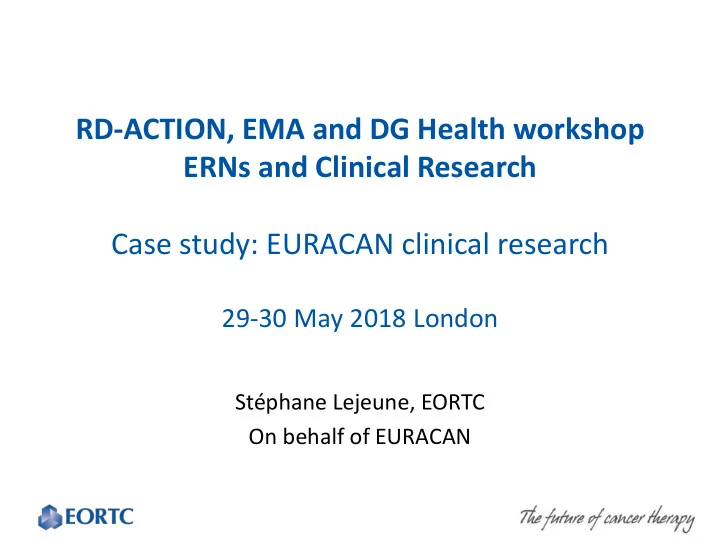

RD-ACTION, EMA and DG Health workshop ERNs and Clinical Research Case study: EURACAN clinical research 29-30 May 2018 London Stéphane Lejeune, EORTC On behalf of EURACAN
Melanoma Patient Network Europe RARE SOLID ADULT CANCERS
Research projects • Added value of EURACAN? Cross tumors. Reinforce access to patients and expertise. • RP-1759 – AYA 12-29 year-old with high grade glioma and non-grade 1 bone and soft tissue sarcoma • To understand better the biology of the tumor, and compare it to children and adults with similar disease. • PILOT to improve the inclusion of young adults into clinical trials. • 50 HGG and 50 sarcoma. FFPE tissue and blood. • Analyses: WES, RNAseq and methylation assay. • RP-1544: Collaboration with Ignyta for enrollment in clinical trial. • Locally advanced or metastatic solid tumor: Soft Tissue Sarcoma, Cholangiocarcinoma, Neuroendocrine Tumors, Ovarian Cancer, Exocrine Pancreas. • To screen for NTRK1/2/3, ROS1 or ALK gene rearrangement to assess eligibility for the STARTRK-2 clinical trial. • More to come incl. phase 2 trials 3
Lessons learned in rare cancers clinical research • Patients, scientific and clinical expertise are rare. Go for international research reaching the critical mass in a reasonable timeframe. Avoid small & irrelevant study. Use robust methodology generating results. Rare patients disserve high level of evidence. Participating clinical sites should be selected on recruitment capacity, facilities and expertise (clinical, pathology,..). Only centralised database and biobank will ensure homogeneous collection and full availability for research incl. future use. Use central laboratory using consistent methodology and offering optimal quality . Histopathological confirmation of the rare cancer diagnostic by central review is critical QA/QC program should be implemented incl. audit. 4
Overview of SPECTA SPECTA is a EORTC platform enabling robust molecular testing, for clinical trials or translational research projects. • A protocol for longitudinal collection of cancer patient data and HBM without immediate interventional intent. • An informed consent form allowing future unspecified use provided ethical committee approval without repeat consent • A logistics, biobanking, and testing infrastructure, to be activated according to the needs of the attached clinical trials or research projects. • Any tumor type incl. rare cancers. Target 100 centers from 20 countries. 40 clinical sites from EURACAN. • EURACAN research infrastructure. 5
SPECTA – workflow 6
Any question? 7
Recommend
More recommend